BLACK AMERICAN HEROES U MAY DO NOT KNOW ABOUT
Bayard Rustin
Bayard Rustin spent years in the background of the shadows of the great civil rights leader of the 1960′s, despite being the man who taught, organized and led them.
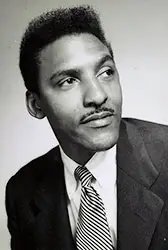
Bayard Rustin was born on March 17, 1912 in West Chester, Pennsylvania. His father was a West Indian immigrant named Archie Hopkins and his mother was Nancy Rustin. Until he was in his teens he believed that Nancy was his sister as he was raised by Nancy’s parents. His grandfather Janifer Rustin was a member of the local African Methodist Episcopal church but his grandmother Julia had been raised a Quaker and much of the Quaker philosophy guided him throughout his years. The Rustins were socially active in the NAACP and in Black civil right causes and counted among their personal friends such dignitaries as James Weldon Johnson and W.E.B. DuBois whom they entertained in their home. This association with notable figures and discussions of the rights of people lead him to engage in activism at an early age.
Bayard attended Wilberforce University, an historically black college in Ohio operated by the AME Church. He was active in extra-curricular activities on campus, including membership in the Omega Psi Phi fraternity and in musical programs (he had received a music scholarship), but he left the school after four years without completing his exams. He later attended Cheyney State Teachers College in Pennsylvania. He became affiliated with the American Friends Service Committee, aQuaker affiliated organization which worked for peace and social justice in the United States and around the world. He participated in one of the groups activist training programs and then moved to Harlem, New York in 1937 and enrolled in the City College of New York soon thereafter . He had become a member of the Communist Youth League the previous year and joined with the Communist movement in trying to free the Scottsboro Boys, a group of nine Black men unfairly accused of raping two white women in Alabama. In later years, his communist affiliation would come back to haunt him but in the 1930′s, communist organizations were often the only ones who tried to help Black people in civil rights matters. He was also a member of the Quaker group The Religious Society of Friends. His life was a flurry of activity, especially when one considers his age at the time. In addition to his activism, he still dabbled in music where he was considered an accomplished tenor vocalist and sang on occasion with Paul Robeson. He was later a member of the Josh White and the Carolinians band, which played gigs in the Cafe Society nightclub in the trendy Greenwich Village. Years later he would record a 10-inch LP for Fellowship Records on which he sang.
During World War II, the United States engaged in the very controversial program of Japanese-American internment. Leery of spies for the Empire of Japan existing on the west coast of the United States, President Roosevelt authorized the incarceration of approximately 120,000 people of Japanese descent in government internment camps, despite the fact that two-thirds of them were American citizens. Rustin took up the cause to help to protect the property belonging to the internees while they were kept in the camps. His talents were again impressive to Muste and he invited Bayard to serve as the FOR’s Secretary for Student and General Affairs, a position which Rustin accepted.
At around the same time, Bayard travelled by bus from Louisville, Kentucky to Nashville, Tennessee and he sat in the second row of the bus. He was asked by several drivers to get out of his seat and move to the back of the bus so a white person could sit in it, a practice common on buses in the south. When Bayard refused, he was arrested miles before his destination, and was beaten by the police and dragged off to jail. He was released without charges but his act of defiance happened in 1942, a full 13 years before Rosa Parks gained fame through her similar refusal. This was not Bayard’s only brush with the law, however.
Consider as you are reading this that this was Black man, taking on national and world issues during the post-war United States. Consider also that this was the period in which the Cold War would start pitting the United States, now considered the world leader in democracy, against the Soviet Union, the dominant force of communism in the world. For Rustin, (a former communist and now socialist) to be taking on the United States and British government could seem to be reckless to his personal well-being as well as political suicide for his reputation. Finally consider that he was a homosexual in the conservative years of the Truman and Eisenhower administrations and it is almost unimaginable, the level of determination, confidence and bravery that he possessed in battling the system when he faced the possibility of personal attacks on so many fronts.
In 1947 Rustin joined with CORE founder George Houser in organizing the Journey of Reconciliation. It was non-violent form of direct action challenging segregation laws on interstate buses in the American south. One year earlier, the U.S. Supreme Court ruled in Irene Morgan vs. Commonwealth of Virginia that segregation in interstate travel violated the Constitution of the United States. Some of the southern states were refusing to comply with the Court’s ruling so the Journey of Reconciliation was devised as a way to directly challenge the segregation and provoke a response from southern law enforcement and legislators. Sixteen male members of CORE were recruited to ride throughout the upper south, composed of eight Black men and eight white men. They ranged in profession from biologist to social worker to student. On the rides, the Black men rode in the front of the bus and the whites rode in back, with Blacks and white sitting next to each other on occasion. Several of the riders were arrested including Rustin, who served 22 days on a chain gang. The white riders faced even worse punishments. North Carolina Judge Henry Whitfield told the white men involved:
“It’s about time you Jews from New York learned that you can’t come down here bringing your niggers with you to upset the customs of the South. Just to teach you a lesson, I gave your black boys thirty days [on a chain gang], and I give you ninety.”
The Journey of Reconciliation was a precursor not only to the Freedom Rides that would take place more than a decade later but also to the other direct action protests that helped to launch the Cilvil Rights movement of the 1960′s (lunch counter demonstrations and enrollment in public state university for instance).
In 1948, Bayard travelled to India to get hands on training in the concept of non-violent civil resistance. He learned directly from the disciples of Gandhi was had been murdered earlier in the year. Over the next few years he travelled to numerous countries, helping to develop movements to promote independence. He also created the Committee to Support South African Resistance in 1951.
In spite of his growing stature in the field of civil rights, Rustin hit roadblock in 1953 that could have derailed the rest of his career. He was arrested in Pasadena, California and charged with vagrancy and lewd conduct after he was found in a car with two men. He plea bargained and served 60 days in a California jail. Soon thereafter he was fired by the Fellowship of Reconciliation, but was hired by the War Resisters League to serve as the organization’s executive secretary. In 1955 he anonymously contributed to the American Friends Services Committees’ publication “Speak Truth to Power: A Quaker Search for an Alternative to Violence.” The 71 page pamphlet analyzed the Cold War, positing non-violent alternatives and was widely acclaimed as one of the most highly recommended pacifist essays.
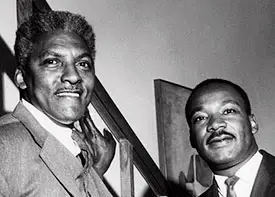 In 1956, Bayard made a decision that would help to change American history. He had become aware of the rising popularity of Dr. Martin Luther King, Jr. and his work in leading the Montgomery Bus Boycott. He sought out the 25 year old King to impress upon him the need to utilize a strategy of non-violent action in regard to protests. At the time, Dr. King was protected by armed bodyguards and he kept a person handgun in his home. Rustin taught King many of the philosophies that he had learned from his experiences in India learning from Ghandi’s disciples. King eventually saw the merit in the non-violence philosophy and the two began working closely together. In January 1957, Rustin worked with King as well as Joseph Lowery, Fred Shuttlesworth, and Ralph Abernathy and founded the Southern Christian Leadership Conference.
In 1956, Bayard made a decision that would help to change American history. He had become aware of the rising popularity of Dr. Martin Luther King, Jr. and his work in leading the Montgomery Bus Boycott. He sought out the 25 year old King to impress upon him the need to utilize a strategy of non-violent action in regard to protests. At the time, Dr. King was protected by armed bodyguards and he kept a person handgun in his home. Rustin taught King many of the philosophies that he had learned from his experiences in India learning from Ghandi’s disciples. King eventually saw the merit in the non-violence philosophy and the two began working closely together. In January 1957, Rustin worked with King as well as Joseph Lowery, Fred Shuttlesworth, and Ralph Abernathy and founded the Southern Christian Leadership Conference.
Through all of his work, Rustin had gained a number of highly influential friends in the civil rights movement, but he gained a number of enemies as well and they were not above using his sexual orientation or his communist past against him. Rustin had been very candid about his sexual orientation and his arrest in California was a matter of public record but most of the general public was unaware of it. This changed in 1960 as Rustin and King were pushing for a stronger civil rights platform at the 1960 Democratic Convention, planning a boycott of it by the followers. Adam Clayton Powell, Jr., then the most powerful Black politician in the United States heard about this he was furious, in part because he felt that King’s ascension in the political world would undermine his own power and influence. He threatened to expose Rustin’s past to the general public and further threatened to accuse King and Rustin of having a sexual affair if they did not call an end to the demonstration. King caved in to the threat and asked Rustin to resign from the movement. Rustin did so for the sake of the movement and was relegated to working behind the scene for years to come. Despite Powell’s blackmailing of him, years later Rustin would come to the Congressman’s aid when the House of Representatives sought to impeach Powell. It was not the last time that his past would be used against him and against the civil rights movement.
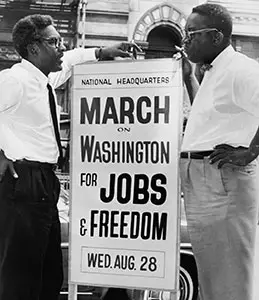 In 1963, Rustin and A. Philip Randolph announced the they were going to organize a demonstration in the Nation’s Capitol, Washington, DC. They recruited unions to support and participate in the march and got varying levels of support. They then reached out to the Council for United Civil Right Leaders, represented by the heads of the six major civil rights organizations, including: Randolph, the head of the Brotherhood of Sleeping Car Porters, James Farmer, the head of CORE, John Lewis, the chairman of the Student Nonviolent Coordinating Committee, King, then the head of the SCLC, Roy Wilkins, president of the NAACP and Whitney Young, the president of the National Urban League. At the outset, Wilkins and Young spoke out against Rustin heading the march effort, worried about his past being used to sabotage the effort. The decision was made therefore, for Randolph to lead the march and Rustin was relegated to the position of deputy organizer. That position was in name only as Rustin had a hand in everything, from the mobilization of publicity campaigns and recruitment of marchers, to arranging the bus schedules, to selecting the order for the speakers, to deciding on the number of bathroom to secure for the event.
In 1963, Rustin and A. Philip Randolph announced the they were going to organize a demonstration in the Nation’s Capitol, Washington, DC. They recruited unions to support and participate in the march and got varying levels of support. They then reached out to the Council for United Civil Right Leaders, represented by the heads of the six major civil rights organizations, including: Randolph, the head of the Brotherhood of Sleeping Car Porters, James Farmer, the head of CORE, John Lewis, the chairman of the Student Nonviolent Coordinating Committee, King, then the head of the SCLC, Roy Wilkins, president of the NAACP and Whitney Young, the president of the National Urban League. At the outset, Wilkins and Young spoke out against Rustin heading the march effort, worried about his past being used to sabotage the effort. The decision was made therefore, for Randolph to lead the march and Rustin was relegated to the position of deputy organizer. That position was in name only as Rustin had a hand in everything, from the mobilization of publicity campaigns and recruitment of marchers, to arranging the bus schedules, to selecting the order for the speakers, to deciding on the number of bathroom to secure for the event.
Bayard helped to navigate through the turmoil surrounding the event. There were disagreements between the organizers on what levels of civil disobedience would take place, with many thinking that the goals of the march were too weak. Finally, a consensus was born and the organization agreed on a set of goals:
In the days proceeding the march, several participants including King and Wilkins received death threats and the Los Angeles Times received a bomb threat, stating that its headquarters would be blown up unless it printed a message on its front page calling President Kennedy a “Nigger Lover.”
Little by little things came together as the day approached, but many in Washington were determined to derail the demonstration. J. Edgar Hoover was convinced that the march was planned and run by the communist party and he passed information about Rustin’s past to segregationist Senator Strom Thurmond. Thurmond declared Rustin to be a “Communist, draft-dodger and a homosexual,” and tried to imply that Rustin and King were involved in a sexual relationship. Whereas many of the Black leaders had earlier tried to distance themselves and the movement away from Bayard, against a racist like Thurmond they were all allied and they closed ranks around Rustin and Thurmond’s bluster amounted to very little.
On the day before the march, saboteurs disabled the speaker systems set up for the crowd. Unable to get it repaired, Walter Fauntroy, a delegate to the United States Congress contacted Attorney General Bobby Kennedy requesting assistance saying “We have a couple hundred thousand people coming. Do you want a fight here tomorrow after all we’ve done?” The U.S. Army Signal Corps was dispatched to fix the system and had it repaired by the next day.
The March on Washington for Jobs and Freedom took place on August 28, 1963. In the days preceding the march, the ever confident Rustin began to have doubts about how many would attend, at one point saying he would be happy if 40,000 showed up. Instead, approximately 250,000 people attended the march, about 60,000 of them white. They marched from the Washington Monument to the Lincoln Memorial where music was played and speeches were made. The last speech was given by Martin Luther King and he addressed the crowd with his “I Have a Dream” speech. The event ended with Rustin reading aloud the list of goals and Randolph joining him to ask the attendees to keep up the fight for racial and economic equality.
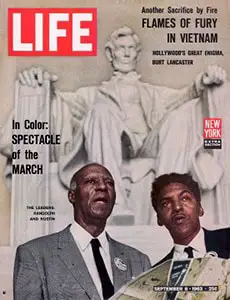 The legacy of the march was that it was looked at like a turning point in the minds of the American public. While many opponents predicted widespread crime and violence in the crowd of a quarter of a million people, none of the marchers was arrested that day. The sheer size of the organized crowd seeking equal rights let the country know that there was power behind the words and a growing mass of people whose voices would be heard one way for another. For Rustin, the march was more successful than he could have dreamed, despite his presence and contributions being marginalized. He need not have worried about history forgetting him though as the September 6, 1963 issue of Life Magazine featured him alongside A. Philip Randolph in a photograph in front of the Lincoln Memorial, identifying them as the leaders of the march.
The legacy of the march was that it was looked at like a turning point in the minds of the American public. While many opponents predicted widespread crime and violence in the crowd of a quarter of a million people, none of the marchers was arrested that day. The sheer size of the organized crowd seeking equal rights let the country know that there was power behind the words and a growing mass of people whose voices would be heard one way for another. For Rustin, the march was more successful than he could have dreamed, despite his presence and contributions being marginalized. He need not have worried about history forgetting him though as the September 6, 1963 issue of Life Magazine featured him alongside A. Philip Randolph in a photograph in front of the Lincoln Memorial, identifying them as the leaders of the march.
Rustin was not finished with his activism. He returned to New York City to lead the New York City School Boycott. He co-wrote (along with Thomas Khan) an influential article entitled “From Protest to Politics” that analyzed the economic implications for Blacks in the changing world of the mid-1960s. He also encouraged Blacks to work together with unions and non-Black religious organization based on their common needs and goals. He put his energy behind labor movements and worked as a writer of the AFL-CIO. He spoke out against the violent aspects of the war in Viet Nam and against the treatment of Jews in the Soviet Union as well as Soviet imperialism in Africa. Although his sexuality was used against him for years, he actively worked in support of gay rights in the 1970′s and 1980′s, testifying on behalf of the New York State’s Gay Rights Bill. He would continue to fight for human rights for the rest of his life.
Bayard Rustin died on August 24, 1987 from a perforated appendix. He was survived by his partner of ten years, Walter Naegle.
When a man of his stature and resume of accomplishment dies, they are usually hailed in admiration, but for Rustin it would take many years for that to happen. For all of his influence and impact on human rights, his sexual orientation still caused even his memory to hide in the background. Over the years, however, thoughts about him would emerge from the shadows to finally put him in the spotlight and showcase the enormity of his contributions. In 2003, a documentary film about him entitled “Brother Outsider: The Life of Bayard Rustin” became a Grand Jury Prize nominee at the Sundance Film Festival. This pointed attention at his life and his works. Several building and schools have been named after him as well as a number of LGBT community programs and centers. A biopic on his life was made entitled “Out of the Past” and a commemorative marker was created in his honor in on the grounds of his high school in his hometown of West Chester, Pennsylvania. He was inducted into the Legacy Walk, a public display which celebrates LGBT history and people and in 2012 and was awarded an honorary membership into the Delta Phi Upsilon fraternity. In 2013 he became an honoree in the United States Department of Labor Hall of Honor and later that year was posthumously awarded the Presidential Medal of Freedom by President Barack Obama, the highest civilian award of the United States.
Though he was forced to live much of his career in shadows that obscured his contributions and accomplishments, history is beginning to paint a new portrait of him, recognizing his role in changing American society and serving as a Great Black Hero.


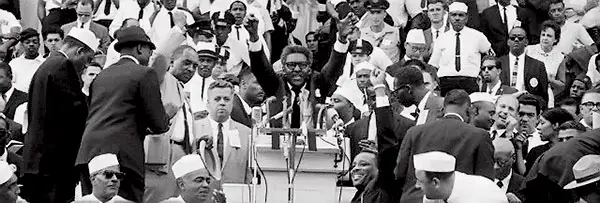
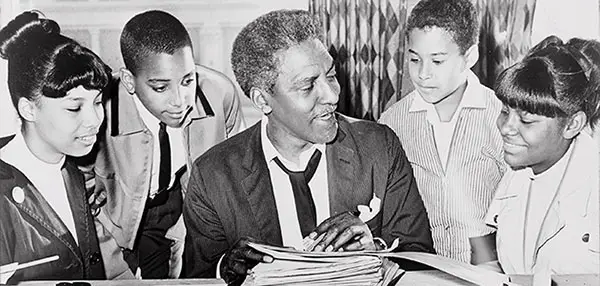
No comments:
Post a Comment
Welcome! If you Like what you see, please comment, share thoughts and Visit our other Links! We will Love to see your comments here!!! Always write nice please! Thank you! Subscribe too please!!